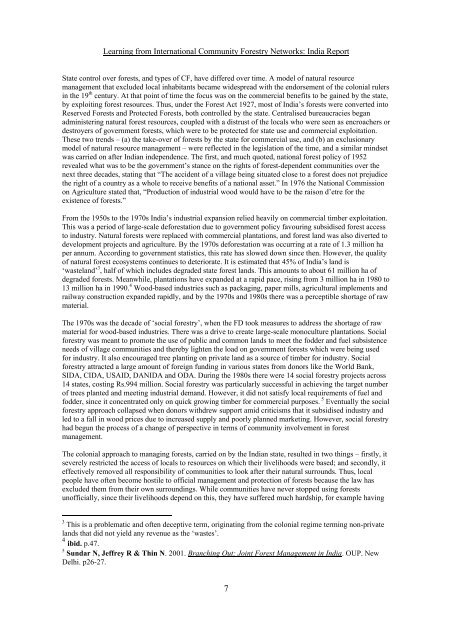Snapshots of International Community Forestry Networks: Country ...
Snapshots of International Community Forestry Networks: Country ...
Snapshots of International Community Forestry Networks: Country ...
Create successful ePaper yourself
Turn your PDF publications into a flip-book with our unique Google optimized e-Paper software.
Learning from <strong>International</strong> <strong>Community</strong> <strong>Forestry</strong> <strong>Networks</strong>: India Report<br />
State control over forests, and types <strong>of</strong> CF, have differed over time. A model <strong>of</strong> natural resource<br />
management that excluded local inhabitants became widespread with the endorsement <strong>of</strong> the colonial rulers<br />
in the 19 th century. At that point <strong>of</strong> time the focus was on the commercial benefits to be gained by the state,<br />
by exploiting forest resources. Thus, under the Forest Act 1927, most <strong>of</strong> India’s forests were converted into<br />
Reserved Forests and Protected Forests, both controlled by the state. Centralised bureaucracies began<br />
administering natural forest resources, coupled with a distrust <strong>of</strong> the locals who were seen as encroachers or<br />
destroyers <strong>of</strong> government forests, which were to be protected for state use and commercial exploitation.<br />
These two trends – (a) the take-over <strong>of</strong> forests by the state for commercial use, and (b) an exclusionary<br />
model <strong>of</strong> natural resource management – were reflected in the legislation <strong>of</strong> the time, and a similar mindset<br />
was carried on after Indian independence. The first, and much quoted, national forest policy <strong>of</strong> 1952<br />
revealed what was to be the government’s stance on the rights <strong>of</strong> forest-dependent communities over the<br />
next three decades, stating that “The accident <strong>of</strong> a village being situated close to a forest does not prejudice<br />
the right <strong>of</strong> a country as a whole to receive benefits <strong>of</strong> a national asset.” In 1976 the National Commission<br />
on Agriculture stated that, “Production <strong>of</strong> industrial wood would have to be the raison d’etre for the<br />
existence <strong>of</strong> forests.”<br />
From the 1950s to the 1970s India’s industrial expansion relied heavily on commercial timber exploitation.<br />
This was a period <strong>of</strong> large-scale deforestation due to government policy favouring subsidised forest access<br />
to industry. Natural forests were replaced with commercial plantations, and forest land was also diverted to<br />
development projects and agriculture. By the 1970s deforestation was occurring at a rate <strong>of</strong> 1.3 million ha<br />
per annum. According to government statistics, this rate has slowed down since then. However, the quality<br />
<strong>of</strong> natural forest ecosystems continues to deteriorate. It is estimated that 45% <strong>of</strong> India’s land is<br />
‘wasteland’ 3 , half <strong>of</strong> which includes degraded state forest lands. This amounts to about 61 million ha <strong>of</strong><br />
degraded forests. Meanwhile, plantations have expanded at a rapid pace, rising from 3 million ha in 1980 to<br />
13 million ha in 1990. 4 Wood-based industries such as packaging, paper mills, agricultural implements and<br />
railway construction expanded rapidly, and by the 1970s and 1980s there was a perceptible shortage <strong>of</strong> raw<br />
material.<br />
The 1970s was the decade <strong>of</strong> ‘social forestry’, when the FD took measures to address the shortage <strong>of</strong> raw<br />
material for wood-based industries. There was a drive to create large-scale monoculture plantations. Social<br />
forestry was meant to promote the use <strong>of</strong> public and common lands to meet the fodder and fuel subsistence<br />
needs <strong>of</strong> village communities and thereby lighten the load on government forests which were being used<br />
for industry. It also encouraged tree planting on private land as a source <strong>of</strong> timber for industry. Social<br />
forestry attracted a large amount <strong>of</strong> foreign funding in various states from donors like the World Bank,<br />
SIDA, CIDA, USAID, DANIDA and ODA. During the 1980s there were 14 social forestry projects across<br />
14 states, costing Rs.994 million. Social forestry was particularly successful in achieving the target number<br />
<strong>of</strong> trees planted and meeting industrial demand. However, it did not satisfy local requirements <strong>of</strong> fuel and<br />
fodder, since it concentrated only on quick growing timber for commercial purposes. 5 Eventually the social<br />
forestry approach collapsed when donors withdrew support amid criticisms that it subsidised industry and<br />
led to a fall in wood prices due to increased supply and poorly planned marketing. However, social forestry<br />
had begun the process <strong>of</strong> a change <strong>of</strong> perspective in terms <strong>of</strong> community involvement in forest<br />
management.<br />
The colonial approach to managing forests, carried on by the Indian state, resulted in two things – firstly, it<br />
severely restricted the access <strong>of</strong> locals to resources on which their livelihoods were based; and secondly, it<br />
effectively removed all responsibility <strong>of</strong> communities to look after their natural surrounds. Thus, local<br />
people have <strong>of</strong>ten become hostile to <strong>of</strong>ficial management and protection <strong>of</strong> forests because the law has<br />
excluded them from their own surroundings. While communities have never stopped using forests<br />
un<strong>of</strong>ficially, since their livelihoods depend on this, they have suffered much hardship, for example having<br />
3 This is a problematic and <strong>of</strong>ten deceptive term, originating from the colonial regime terming non-private<br />
lands that did not yield any revenue as the ‘wastes’.<br />
4 ibid. p.47.<br />
5 Sundar N, Jeffrey R & Thin N. 2001. Branching Out: Joint Forest Management in India. OUP. New<br />
Delhi. p26-27.<br />
7

















![CynefinFramework final [Read-Only]](https://img.yumpu.com/19017304/1/190x135/cynefinframework-final-read-only.jpg?quality=85)